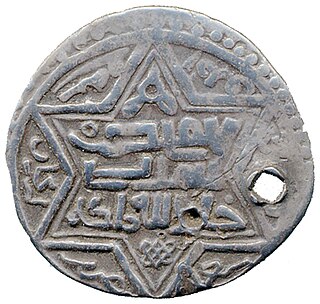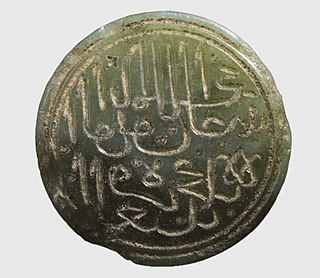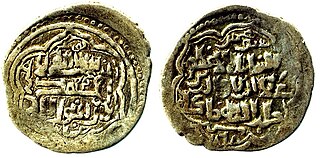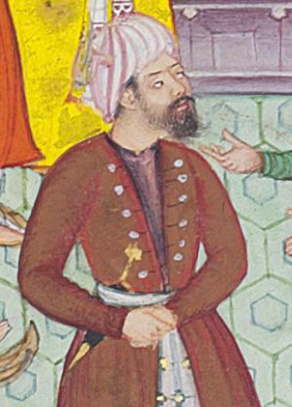
The Qara Qoyunlu or Kara Koyunlu, also known as the Black Sheep Turkomans, were a culturally Persianate, Muslim Turkoman monarchy that ruled over the territory comprising present-day Azerbaijan, Armenia, northwestern Iran, eastern Turkey, and northeastern Iraq from about 1374 to 1468.

The Candar dynasty, also known as the Isfendiyar dynasty, was an Oghuz Turkic princely Anatolian dynasty that reigned in the territories corresponding to the provinces of Eflani, Kastamonu, Sinop, Zonguldak, Bartın, Karabük, Samsun, Bolu, Ankara and Çankırı in present-day Turkey from the year 1291 to 1461. The region was known in Western literature as Paphlagonia, a name applied to the same geographical area during the Roman period.
Uthman Beg or Osman Beg was a late 14th and early 15th-century leader of the Turkoman tribal federation of Aq Qoyunlu in what is now eastern Turkey, Iran, Azerbaijan and Iraq.

Abu NasrQara Yusuf ibn MohammadBarani was the ruler of the Qara Qoyunlu dynasty from c.1388 to 1420, although his reign was interrupted by Tamerlane's invasion (1400–1405). He was the son of Qara Mahammad Töremish, a brother-in-law to Ahmad Jalayir.

The Eretnids were a dynasty that ruled a state spanning central and eastern Anatolia from 1335 to 1381. The dynasty's founder, Eretna, was an Ilkhanid officer of Uyghur origin, under Timurtash, who was appointed as the governor of Anatolia. Some time after the latter's downfall, Eretna became the governor under the suzerainty of the Jalayirid ruler Hasan Buzurg. After an unexpected victory at the Battle of Karanbük, against Mongol warlords competing to restore the Ilkhanate, Eretna claimed independence declaring himself the sultan of his domains. His reign was largely prosperous earning him the nickname Köse Peyghamber.

Qāḍī Aḥmad Burhān al-Dīn was vizier to the Eretnid rulers of Anatolia. In 1381, he took over Eretnid lands and claimed the title of sultan for himself. He is most often referred to by the title Qadi, a name for Islamic judges, which was his first occupation.
Eudokia Megale Komnene, was a Trapezuntine princess and a member of the powerful Byzantine Komnenos dynasty as a daughter of Emperor Alexios III of Trebizond.

Ala al-Din Eretna was the first sultan of the Eretnids, reigning between 1343–1352 in central and eastern Anatolia. Initially an officer in the service of the Ilkhanate officer Chupan and his son Timurtash, Eretna migrated to Anatolia following Timurtash's appointment as the Ilkhanid governor of the region. He took part in Timurtash's campaigns to subdue the Turkoman chiefs of the western periphery of the peninsula. This was cut short by Timurtash's downfall, after which Eretna went into hiding. Upon the dissolution of the Ilkhanate, he aligned himself with the Jalayirid leader Hasan Buzurg, who eventually left Anatolia for Eretna to govern when he returned east to clash with the rival Chobanids and other Mongol lords. Eretna later sought recognition from Mamluk Egypt to consolidate his power, although later he played a delicate game of alternating his allegiance between the Mamluks and the Mongols. In 1343, he declared independence as the sultan of his domains. His reign was largely described to be prosperous, with his efforts to maintain order in his realm such that he became known as Köse Peyghamber.
The Battle of Kırkdilim was fought in July 1391 or 1392 between the Ottoman Ertuğrul Çelebi son of Bayezid I, and Kadi Burhan al-Din, ruler of northeastern Anatolia. The details of the battle are debated: Burhan al-Din's court poet Ibn Ardashir presents Bayezid's campaign being ended by a major victory for his master, which temporarily halted Ottoman expansion in Anatolia, but the contemporary letters of Manuel II Palaiologos, who accompanied Bayezid on his Anatolian campaigns, contain no indications of a major clash, and point to the expedition having been an Ottoman success overall.

Qara Mahammad was a bey of the Qara Qoyunlu and father of Qara Yusuf.
Fakhr al-Din Qutlugh-bey was the second Aq Qoyunlu bey, ruling from 1362-1389. His full name was Haji Fakhr al-Din Kutlug ibn Tur Ali-bey.
Ahmad ibn Kutlug, was the third bey of the Aq Qoyunlu confederation (1389-1403).

Ghiyath al-Din Muhammad I was the second Sultan of the Eretnids in central and eastern Anatolia, ruling from 1352 until his death. He was enthroned at a young age and struggled to maintain his authority over the state his father, Eretna, had founded. Although he was initially preferred over his older brother Jafar, Muhammad was deposed by his emirs early into his reign and was replaced by Jafar. After some time in exile, he returned, restored his throne, and killed his brother. Though, throughout his reign, he dealt with rebellions and lost land to local Turkoman lords, the Dulkadirids, and the Ottomans. After putting an end to his former vizier Khoja Ali Shah's revolt and returning to the capital, Kayseri, Muhammad was murdered by his emirs, who crowned his son Ali as the new sultan.
Nasir al-Din Mehmed Beg was the ruler of Dulkadir from 1399 until his death. He came to power with the intervention of the Ottoman Sultan Bayezid I amidst the internal struggles within the Dulkadirids and forced his cousin Sadaqa to flee from Elbistan, the capital. During the Ottoman Interregnum (1402–13), Mehmed supported Bayezid's son Mehmed Chelebi, who became the new sultan succeeding his father, Bayezid I. While Nasir al-Din Mehmed was involved in sporadic clashes with the Mamluks, he enjoyed peace with them towards the end of his reign, marrying his daughter to the Mamluk Sultan and commissioning the construction of madrasas and other buildings in regions outside his control, such as in Jerusalem.
Suleiman Beg was the ruler of Dulkadir from 1442 until his death. During the reign of his father's, Nasir al-Din Mehmed, he served as the wali (governor) of Kayseri. His reign was relatively uneventful. His major accomplishment was the arrangement of the political marriages of his daughters to the Ottoman Sultan Mehmed II and the regnant Mamluk Sultan Sayf al-Din Jaqmaq. Towards the end of his reign, Suleiman was involved in the internal struggle of the Aq Qoyunlu and led an unsuccessful siege on Çemişgezek. He had numerous offspring, among whom four sons would consecutively rule the state. He was succeeded by Malik Arslan.

Ala al-Din Ali was the third Sultan of the Eretnids ruling from 1366 until his death. He inherited the throne at a very early age and was removed from administrative matters. He was characterized as particularly keen on personal pleasures, which later discredited his authority. During his rule, emirs under the Eretnids enjoyed considerable autonomy, and the state continued to shrink as neighboring powers captured several towns. The capital, Kayseri, temporarily came under Karamanid control. Kadi Burhan al-Din rose to power as the new vizier and dispatched Ali to lead several campaigns, most of which were unsuccessful. Ali died of the plague in Kazova in an expedition to subdue Shadgeldi, the emir of Amasya.

Mutahharten, also known as Taharten, was Emir of Erzincan from 1379 until his death. Erzincan was previously ruled by emirs who exercised autonomy as vassals of the Eretnids. Mutahharten claimed sovereignty from the Eretnids when he assumed power, which prompted the Eretnid Sultan Ala al-Din Ali to go on an expedition to reinstate his authority over Erzincan. While Mutahharten ultimately repelled Ali, the latter was replaced by his vizier Kadi Burhan al-Din, who was determined to restore the sultanate's former boundaries. Burhan al-Din and Mutahharten were involved in a long-lasting conflict. Upon the advent of Timur, Mutahharten contently swore allegiance and halted his campaigns in Anatolia, but Timur's departure reignited the conflict between Mutahharten and Burhan al-Din. Often overpowered by his enemies, Mutahharten forged alliances with various groups but did not hesitate to turn against his former allies, such as the Aq Qoyunlu, when he saw fit. On the other hand, Mutahharten's relations with the Empire of Trebizond and his Christian subjects were consistent, as he favored them for their economic contribution to his realm through trade.
Ghiyath al-Din Ahi Ayna Beg was Emir of Erzincan from 1348 until his death. Thought to be a local ahi, he gained control of the region and the city of Erzincan through a purchase from his predecessor sometime before 1348. He was initially loyal to Eretna, after whose death he practiced some degree of autonomy within the Eretnid Sultanate. He waged multiple wars against the Empire of Trebizond and Kingdom of Georgia. He is recorded to have died a shaheed (martyr) and was succeeded by Pir Husayn.
Pir Husayn was Emir of Erzincan from 1362 until his death. He was originally the ruler of Karahisar and arrived in Erzincan on 8 June 1362 and succeeded Ahi Ayna, who died on 2–3 July 1362 reportedly as a shaheed (martyr). In Abu Bakr Qutbi's Tarikh-i taqwim, Pir Husayn is mentioned as an emir-zada directly following the statement about Ahi Ayna's demise, hinting at the possibility he was Ahi Ayna's son.
Taj al-Din Chelebi was Beg of Limnia in northeastern Anatolia from 1367 until his death.











